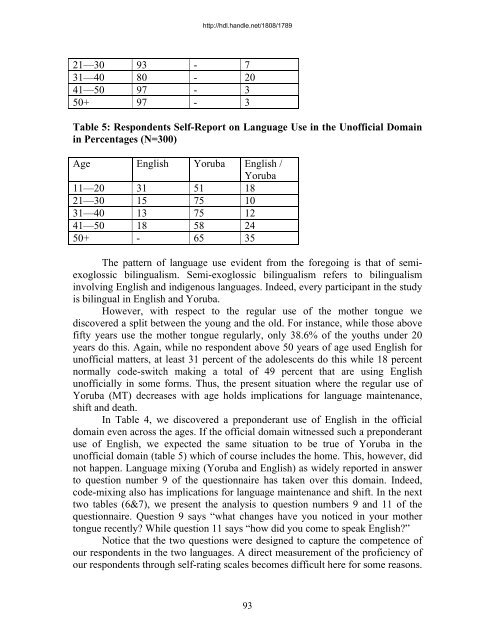LANGUAGE CONTACT AND LANGUAGE ... - KU ScholarWorks
LANGUAGE CONTACT AND LANGUAGE ... - KU ScholarWorks
LANGUAGE CONTACT AND LANGUAGE ... - KU ScholarWorks
Create successful ePaper yourself
Turn your PDF publications into a flip-book with our unique Google optimized e-Paper software.
http://hdl.handle.net/1808/1789<br />
21—30 93 - 7<br />
31—40 80 - 20<br />
41—50 97 - 3<br />
50+ 97 - 3<br />
Table 5: Respondents Self-Report on Language Use in the Unofficial Domain<br />
in Percentages (N=300)<br />
Age English Yoruba English /<br />
Yoruba<br />
11—20 31 51 18<br />
21—30 15 75 10<br />
31—40 13 75 12<br />
41—50 18 58 24<br />
50+ - 65 35<br />
The pattern of language use evident from the foregoing is that of semiexoglossic<br />
bilingualism. Semi-exoglossic bilingualism refers to bilingualism<br />
involving English and indigenous languages. Indeed, every participant in the study<br />
is bilingual in English and Yoruba.<br />
However, with respect to the regular use of the mother tongue we<br />
discovered a split between the young and the old. For instance, while those above<br />
fifty years use the mother tongue regularly, only 38.6% of the youths under 20<br />
years do this. Again, while no respondent above 50 years of age used English for<br />
unofficial matters, at least 31 percent of the adolescents do this while 18 percent<br />
normally code-switch making a total of 49 percent that are using English<br />
unofficially in some forms. Thus, the present situation where the regular use of<br />
Yoruba (MT) decreases with age holds implications for language maintenance,<br />
shift and death.<br />
In Table 4, we discovered a preponderant use of English in the official<br />
domain even across the ages. If the official domain witnessed such a preponderant<br />
use of English, we expected the same situation to be true of Yoruba in the<br />
unofficial domain (table 5) which of course includes the home. This, however, did<br />
not happen. Language mixing (Yoruba and English) as widely reported in answer<br />
to question number 9 of the questionnaire has taken over this domain. Indeed,<br />
code-mixing also has implications for language maintenance and shift. In the next<br />
two tables (6&7), we present the analysis to question numbers 9 and 11 of the<br />
questionnaire. Question 9 says “what changes have you noticed in your mother<br />
tongue recently? While question 11 says “how did you come to speak English?”<br />
Notice that the two questions were designed to capture the competence of<br />
our respondents in the two languages. A direct measurement of the proficiency of<br />
our respondents through self-rating scales becomes difficult here for some reasons.<br />
93
















